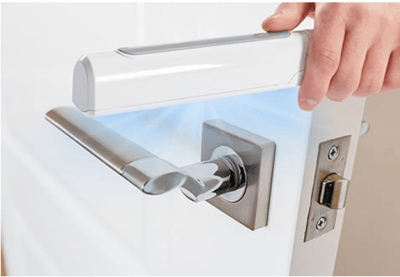How to select a safe UV solution

UV solutions can create a cleaner, safer environment for everyone who walks into your facility. UVC is a known disinfectant for air, water, and nonporous surfaces, and in studies has been shown to inactivate SARS-CoV-2, the virus that causes COVID-19.
But if you're considering using UV products in your facility, it's only natural that one of the first questions likely involves safety. It's well-documented that UVC is dangerous to unprotected eyes and skins, and when safety is a top priority, this could be an area for concern.
Not to mention there are cases where UVC products have failed. For example, UV lights in a Georgia elementary school malfunctioned, exposing students. The school district chose to get rid of the system. A similar situation in California resulted in millions of dollars worth of equipment sitting in boxes after concerns about ozone.
Situations like these have led to a lot of confusion about the realities of UV solutions, and if they are really worth the cost.
Scientists agree that UVC is an effective disinfection tool, and experts acknowledge that it has been used safely in applications for decades.
So how do you know a UVC system is safe? We explore several ways to find a solution that's right for your application.
Selecting a safe UV solution
The first step to selecting a safe UV solution is to know your application and goals.
There are multiple options for UVC solutions:
- Mobile units that primarily target surface disinfection
- HVAC UVC fixtures that target cleaner equipment and air
- Air disinfection units with enclosed UVC
- Upper-air units proven to decrease transmission of pathogens
A combination of these products is likely the most effective way to disinfect a building.
Here are some questions to help guide your decision as you select a product that's right for you:
- Are you trying to provide augmented air quality in conference rooms during meetings? If so, consider an enclosed UVC system that works to continuously disinfect air. Our top choice is the UV FAN by Light Progress, a unit that's whisper quiet and has a portable option. The unit brings in air, disinfects it with a UVC lamp, then distributes clean air back into the room. Plus, the titanium dioxide filter never has to be replaced.
- Are you trying to improve air quality coming out of your HVAC system? If so, there are two different fixture options. On-coil UVC fixtures work to disinfect the system, preventing build-up of pathogens on equipment. In-duct UVC fixtures work to cleanse the air as it passes through the system, before it enters the building. Because all HVAC systems are different, we recommend a custom solution.
- Are you trying to reduce pathogen transmission within an occupied space? If so, upper-air fixtures may be the best option. Upper-air units have been installed in hospitals for many years, first used to reduce the transmission of Tuberculosis. We recommend upper-air units by Light Progress. We also recommend commissioning for all upper-air units to ensure UVC beams are pointed in the proper direction.
- Do you have surfaces you're trying to disinfect with UVC? If so, consider mobile UVC units or tabletop UVC units. These fixtures may have to run multiple times to cover every surface in a room, but they disinfect all surfaces within a room.
It's also important to know the difference between the types of products. Most disinfection systems use UVC instead of UVA or UVB, which are more typical in products like tanning beds.
Traditional UVC products use 254 nm light to reduce pathogen levels. These are the most common type of product on the market right now, although more manufacturers are producing LED UVC and far-UVC products. LED UVC and far-UVC lamps both use different wavelengths to disinfect.
Safety guidelines for UV solutions
UV solutions are much different than any other lighting solution. Safety precautions must be a priority, and the system should be installed to reduce risks once the system is up and running.
Here are a few basic safety guidelines to follow:
- Ensure that the UVC solution you're using does not produce any ozone. (UVC products that use 254 nm technology typically do not produce ozone. Ozone is produced from shorter wavelengths.)
- The safest solutions fully enclose UVC energy, shielding occupants from the harmful rays.
- Upper Air UVC solutions should be commissioned to ensure proper safety and installation
- Surface disinfection systems should have proper occupancy controls and safeguards to ensure that no one is accidentally exposed to UVC.
- HVAC UVC systems should incorporate sight glasses and door switches to check for proper operation and safeguard technicians from accidental exposure.
- Dosimeters are an effective tool for measuring any UVC exposure.
We explain some of the basics of installing UV fixtures in the video below.
Warning signs of unsafe UV solutions
There are several warning signs to be aware of before you purchase UV products.
First, we recommend only purchasing UV products from trusted, reputable manufacturers. Safety concerns from experts primarily revolve around products like UV wands, which are readily available to purchase online.

Unfortunately, there are products that include claims that are false, misleading, incomplete, or do not comply with federal regulations. Any details concerning the safety and usage of the product should be thoroughly reviewed.
Second, be wary of manufacturers who may have used the COVID-19 pandemic as an opportunity to expand into a new field where they have little expertise. We recommend working with a company who has a long track record with UV products.
Consultation for a safe UV solution
If you are considering installing a UV solution in your facility, the first step we recommend is a free consultation. Our team of experts will offer a variety of solutions that will work for your facility, with safety as the first priority.
We have spent the last two years reviewing dozens of companies that sell UV products, and we only partner with manufacturers we know and trust, and who have proven track records, especially when it comes to safety.
If you're ready to find the right UV solution, do not hesitate to contact us.











